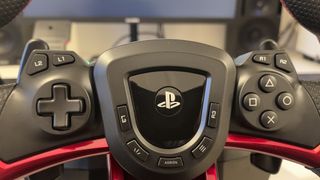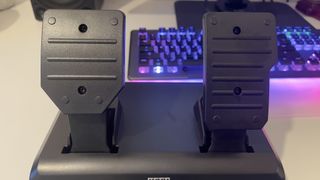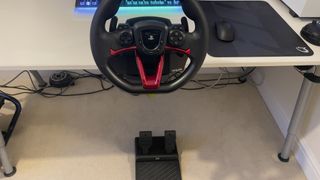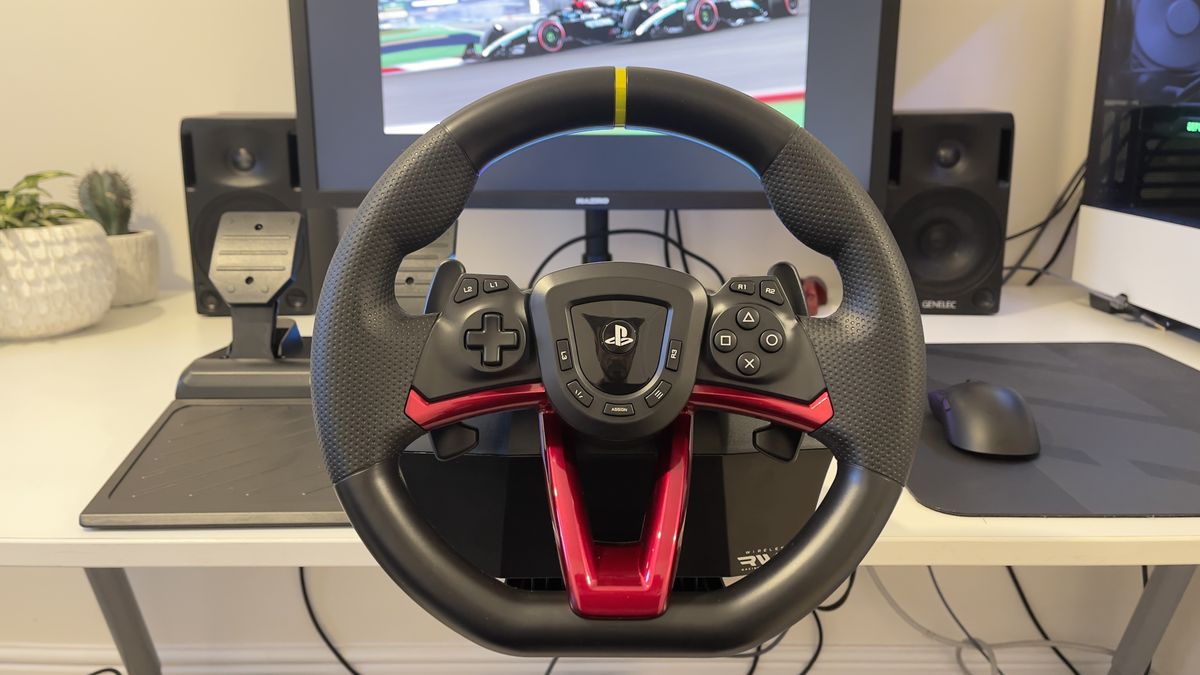Products You May Like
Hori Wireless Racing Wheel Apex: One-minute review
Look, it’s hard to make one of the best racing wheels at an affordable cost. Compromises have to be made in order to hit a lower price point, and there are no good options when it comes to what to jettison.
In the Hori Wireless Racing Wheel Apex, Hori has managed to retain decent build quality and even an impressive wireless function that far pricier wheels don’t feature, but after a few hours of use it’s clear that this is a Pyrrhic victory – the driving experience makes you miss the features it’s gone without.
Specifically: a longer brake pedal actuation, a sturdier pedal base that stays in place, and – although it’s a stretch at the price – force feedback. With these elements missing, the fundamental fun and increased precision you gain from inputting via a wheel is unfortunately offset by too much fiddling and repositioning with the pedals, and an unsatisfying on/off feel to braking.
Of course, that’s the sim racer in me talking, with an awareness of how far more expensive direct drive setups feel in the best racing games. If you put this wheel in the hands of a younger gamer whose curiosity for racing might not warrant sinking two grand on a Fanatec direct-drive rig quite yet, they’ll likely just appreciate the pros and won’t miss the cons too much.
The same goes for casual players whose appetite for racing is infrequent and who just want to try a different style of controlling their vehicles in game. Ultimately, then? The Hori Wireless Racing Wheel Apex’s quality hinges entirely on the use case, and the audience. Just know that there are dramatically better options out there for only a small amount of extra cash.

HORI Wireless Racing Wheel Apex: Price and availability
- List price: $119.99 / £159.99 / around AU$319
- As budget-friendly as you’ll find for a racing wheel
- Logitech’s G29 is only £40 more now in UK, and offers force feedback
You can’t fault Hori’s ability to achieve a really attractive entry-level price point – in fact, you’ll struggle to find a cheaper model from a reputable brand. This pricing alone makes the Hori Wireless Racing Wheel Apex worth considering.
It’s up against dominating competition from an old stalwart, the Logitech G29, in the UK which is now going for £199 and offers force feedback, superior build qualit,y and functionality. In the US, where the G29 still costs $299, the Hori Wireless Racing Wheel Apex seems a lot more reasonable.
Hori Wireless Racing Wheel Apex: Specs
| Price | $119.99 / £159.99 / around AU$319 |
| Weight | 6.67 lb / 3028 g |
| Peak torque | N/A |
| Features | Wireless connection, up to 10 hours of battery life |
| Connection type | USB-A (recharging) |
| Compatibility | Playstation 5, PlayStation 4, PC |
| Software | Hori Device Manager |
Hori Wireless Racing Wheel Apex: Design and features
- Smart appearance
- Ergonomic layout
- Flawed pedal design
You’ll find even less metal here than at the Teen Choice Awards, but this wheel’s finish and aesthetic do a lot to flatter the plastic construction materials. This being a PlayStation wheel officially licensed by Sony, you’ll find all the buttons from a DualSense Wireless Controller mapped around the centre of the wheel in a sensible ergonomic layout. Behind them are two plastic paddle shifters, and above the central PlayStation logo are a couple of toggle switches for PS4 / PS5 / PC compatibility.
It’s an attractive peripheral for the price, and the chromed plastic on the lower half does a lot to elevate the look. The gold centre band is a useful touch that adds some motorsport cred to the design, and all the face buttons feel really nice to press – perhaps owing to Hori’s chops in the fight stick market.
I also appreciated the rubberized grips, which added a lot to the feel during a race and kept my hands exactly where I needed them, even in sweatier sessions.

Down at your feet though, the design fares less well. There’s no hiding how plasticky that throttle and brake are, nor how insubstantial they feel to operate.
A lot of this comes down to the design. The base just isn’t big enough to distribute your stamping force across a wide enough surface area to prevent the pedals from shifting or twisting under your feet. Even if you push the unit right up against a wall so it can’t move backwards, you still feel a twist if you brake hard. There’s not much that can be done about this – there are no mounting holes for a racing seat, and the rubber stays aren’t sticky enough to keep it in place on carpets or hard floors.
Time for the ace up the Hori Wireless Racing Wheel Apex’s sleeve, though: wireless operation. Alright, not totally wireless – you still need to connect the wheel to the pedals, via an old-school modem-like input (like the ones Thrustmaster and Fanatec use in bases). But from wheel to console or PC, it’s cable-free.
Up to 10 hours of battery life is promised on the spec sheet, and pairing it to the USB-A dongle is a simple procedure. It’s a genuinely impressive addition, although you can’t help but wonder if the overall experience might have benefitted from that expense being spent on the driving feel instead.
Hori Wireless Racing Wheel Apex: Performance
- Functional but basic
- Limited steering angle and brake actuation
- Centering spring hampers car feel
There are two ways to appraise this wheel. Given that it’s aimed squarely at the beginner end of the market, the first is to simply weigh up the merits of using a wheel input versus a controller – the increased precision offered, the way you can catch those spins quicker and correct them more easily. The advantage of holding a consistent steering angle through a corner is something that’s much trickier when you’re trying to be precise with a tiny analog stick. It won’t make you faster straight away, but in the long run, you’re always going to feel the benefits of a wheel peripheral over a pad.
The second approach – and this is where Hori is sweating – is to evaluate this wheel against similarly priced competitors. And that’s where it struggles to make a compelling argument.
Here are the elements that hamper your performance: firstly, the brake pedal. In addition to the issues with keeping the pedal base in place, the brake pedal itself has a tiny amount of actuation, and that creates the sensation that you’re pressing the brake button, rather than applying progressive pressure to the brakes. In other words, it negates the benefits of braking using a pedal instead of a trigger on a pad.
It’s not all bad, though. To the Hori Wireless Racing Wheel Apex’s credit, there’s a decent amount of resistance to the spring on the brake, slightly more than on the throttle, which feels just about resistant enough. And which, crucially, has just about enough travel.

Next performance-limiting issue: the centering spring strength of the wheel. This is not a force feedback peripheral, so there’s no tarmac rumble, no dynamic resistance to turn-in, and no steering wheel snaps when your back end hits traction loss and steps out. That’s fair enough. This is a budget wheel, and implementing both the hardware and the software compatibility for force feedback aren’t cheap.
So in its place is a simple spring which brings the wheel back to its centre point when you’re not exerting steering inputs to the left or right. The amount of tension when you’re moving the wheel from centre to a degree of rotation feels fine, and likewise when you’re moving it back from that rotated position. But as it hits the centre point, the wheel snaps into position so aggressively that it affects a car’s stability in-game.
There’s also the 270-degree rotation range to consider. It’s enough angle to enjoy the feeling of sending a car through a corner in most scenarios, but it’s quite limited by the standards set by its peers and situations will crop up where you’ll wish for more angle. Taking the hairpin at Monaco in F1 24, for example, or trying to park in Euro Truck Simulator 2. Many wheels offer up to 900 degrees, and truthfully I’ve sometimes felt like I could get away with much less until I used this Hori Wireless Racing Wheel Apex.
And that leads to the final point about this wheel. It’s not to be knocked or ruled out of contention, because the build quality and features are decent for the price. But that caveat is crucially important. It’s the only context in which such a wheel makes sense.
And that means you should consider if this wheel is going to satisfy your needs in the long run, or whether you’ll probably end up buying a more expensive upgrade later down the line that adds in the features you’ll miss here.
Should I buy the Hori Wireless Racing Wheel Apex?

Buy it if…
Don’t buy it if…
Also consider…
If the Hori Wireless Racing Wheel Apex doesn’t meet your need (for speed), these similarly priced rivals are worth a look.
| Row 0 – Cell 0 | Hori Wireless Racing Wheel Apex | Thrustmaster T248 | Logitech G920 |
| Price | $119.99 / £159.99 / around AU$319 | $399.99 / £299.99 / $599.99AU | $299.99 / £349.99 / AU$549.95 |
| Weight | 6.67 lb / 3,028 g | 6 lb / 2,700 g | 10.7 lb / 4,885 g |
| Peak torque | N/A | 3.5Nm | 2.3Nm |
| Features | Wireless connectivity | Force feedback, digital display, magnetic paddle shifters, 25 input buttons | Force feedback, LED rev display, clutch pedal, 900-degree rotation |
| Connection type | Wireless | USB-A | USB-A |
| Compatibility | PlayStation 5, PlayStation 4, PC | PlayStation 5, PlayStation 4, PC | PC & Xbox or PC & PS5 |
How I tested the Hori Wireless Racing Wheel Apex
- One week of regular use during testing
- Tested with PC and PS5
- Racing sims and arcade titles tried
Since the Hori Wireless Racing Wheel Apex’s pedal base can’t be mounted to a sim racing rig, my Playseat gathered dust for a week while I clamped this wireless rig to my desk and put in the hours with Gran Turismo 7, F1 24, and The Crew Motorfest.
I’ve been testing wheels since the early 2010s when the Logitech G27 sat resplendent on the sim racing throne, and in the intervening year,s I’ve taken hairpins and sent many a purple sector with high-end direct drive models and budget offerings alike.
As a point of comparison, I dug out Thrustmaster’s similarly priced T128 wheel for a feature, build quality and driving feel reference, setting aside my usual Thrustmaster T-GT II belt-driven wheel (and the sim rig it’s attached to) for a while
First reviewed December 2024
